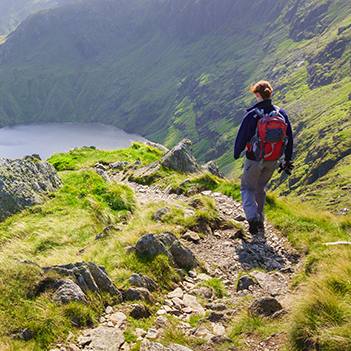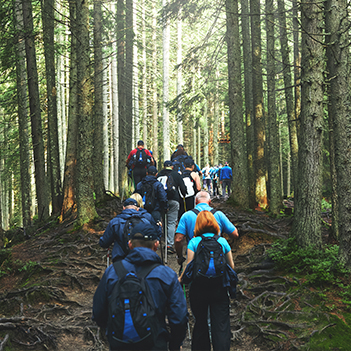Stroud Commons
It had rained overnight and on the drive we experienced some low cloud. We had dry, though overcast weather for the rest of the day. During the walk, we had frequent excellent viewing positions, which would have been enhanced by the sun! We arrived at Rodborough Common to find a large group of eager walkers. Bristol & West and Wilts groups were well represented, but it was especially pleasing to see a fair number of new walkers. It was also good to see survivors of last weekend’s snowy WF50 Marshall’s walk. We set off south from the car park near Rodborough Fort across the Common, walked behind The Bear of Rodborough and turned up a muddy track to cross the road at the northern end of Minchinhampton Common. We followed a route alongside the east of the golf course, turning south east to cross Cirencester Road and alongside a high path which led into Minchinhampton. We paused at Holy Trinity Church and noted the unusual spire. The original was pulled down for safety reasons in 1563, after the Nave arches supporting it were found to be failing, and the stub was then completed with a "coronet" structure. We passed through this pretty town and in Chapel Lane visited the unusual circular layout of the headstones of the Baptist Church. We descended grassy slopes to the valley bottom and followed a muddy path through the woods to Longfords Mill, diverting to view the impressive Gatcombe Water. The local textile industry dates back to the Middle Ages and evidence for a mill at Longfords, recorded in 1304, describes it as a water mill which is interpreted as meaning it was a corn mill. However, by the 1600s it was a combined fulling and corn mill, typical of many in the valleys. The Mill has now been converted into attractive residential accommodation. We turned west along Avening Road and near Iron Mills we turned south for a long climb alongside a brook. The path through the woods was muddy at times. We reached a path, Shipston’s Grave Lane, alongside a field and at the top, turned west over a stile, turning north west to descend gradually across fields. We passed through a wood and into another field, where we had a morning stop on the banks, enjoying the views. We continued the descent to Nailsworth, passing through the town westwards and through Shortwood. At a bend we took a restricted byway swooping through well-kept parkland past the substantial Lower Letheredge Farmhouse. It ascended to a minor road, which led us into Nymphsfield. The lunch stop here was enhanced by a drink at the Rose and Crown.
It seemed to get colder. We continued along the road to turn east into Woodchester Park, where we were diverted around the Mansion and descended for the long path through the valley. Woodchester Mansion is an unfinished, Gothic revival mansion house, formerly known as Spring Park. The mansion was abandoned by its builders in the middle of construction in the mid 1870s. Floors, plaster and whole rooms are missing inside, but it appears complete from the outside. Stroud District Council eventually purchased it and in 1992 leased it to a building restoration trust, the Woodchester Mansion Trust. The surrounding parkland is owned by the National Trust. Here, I passed the leader’s baton to my experienced second in command, who led the walk steeply north west up through the vineyard over to Selsley Common, along it and descending to the Nailsworth Valley. Meanwhile, John and I joined the main A46 at Inchbrook and followed a cycle path north through the valley. At The Old Fleece, we rejoined the route the others took later. We climbed up the extremely steep Rooksmoor Hill, with several pauses to enjoy the attractive views to Selsley. We continued climbing up Bowl Hill and emerged onto Rodborough Common. We crossed the path strewn summit and with reference to Rodborough Fort arrived back at 4.40 pm. The rest arrived from only ten minutes later. All seemed to have enjoyed the route, which was 18.4 miles with 2,900 feet of ascent.
Bruce Young














